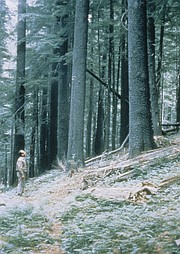White pine blister rust: Restoring the Idaho state tree
“The glory days of white pine harvest were the days of big timber, big men and big money. Towering stands of virgin white pine literally enveloped… the Inland Northwest before 1900, stands that produced a versatile wood good for match sticks, fruit boxes, door and window parts, trim and molding, and fine finish lumber.”
— from “White Pine in the
American West: A Vanishing Species” by L. F. Neuenschwander
In the last issue of Northwest Mining & Timber, we discussed blister rust disease on whitebark pine. Here we address the rust on western white pine. Whitebark pine is a high elevation species of critical ecological value, while western white pine is a mid-elevation species valued for its timber. The impacts of white pine blister rust have been devastating on both species.
History: Five million acres of western white pine forest occupied the best growing sites in and near North Idaho in the late 1800s. While other tree species were also present, it was the large, prized white pine timber that lured lumber mills west from the largely harvested eastern white pine forests in the Lake States. It dominated the local timber industry from 1900 to 1965. Western white pine was declared the Idaho’s official state tree in 1935.
But the “limitless” supply of white pine was not to last. In 1910, blister rust-infected western white pine seedlings from France were shipped to British Columbia. The disease spread rapidly, and in a couple of decades was found in Idaho. A few decades later, most of the great western white pine forests were gone. While the rust epidemic was the main cause, native bark beetles, wildfire and logging accelerated the decline. By the end of the century, the amount of white pine in Idaho’s forests was reduced by 90 to 95 percent.
Disease control: A number of disease control measures were tried early in the epidemic, including quarantines, antibiotics and most notably “Ribes eradication.” The rust has a complex disease cycle which requires two hosts. Only spores produced on gooseberry and current shrubs (“Ribes spp”) will infect pines, so in theory, elimination of the Ribes would protect the pines. It was the time of the Great Depression in the 1930s, and government programs put men to work pulling, digging, spraying and scraping Ribes. An average of 25,000 men were employed from 1930 to 1946 in the Inland Northwest. In the end, the effort failed to reduce the Ribes population sufficiently to protect the pines, and was eventually discontinued in 1967.
Current control efforts involve planting rust-resistant trees and pruning young trees. While western white pine was highly susceptible to the rust, an occasional tree would appear totally healthy, even though its neighbors would be heavily infected. The rust infects through pine needles, then grows into the branch to form a “canker.” When disease-free trees were crossed with each other, many of the seedlings from those crosses also remained free of cankers, thus demonstrating genetic resistance. Planting rust-resistant seedlings began in the 1970s; about 250,000 acres were planted by the 1990s. While this was a significant accomplishment, it represents only about 5 percent of the species’ historic acreag Genetic resistance means some trees will remain healthy when exposed to the rust. The proportion that remains healthy varies from one plantation to another, because some sites are more favorable for the rust than others. Recent surveys of some 20 plantations found that about half of the trees were still healthy at about 25 years of age in the average plantation, the rest being infected or dead. The best result was 94 percent healthy, and the worst was 13 percent. This high variability means some stands will likely contain a high proportion of white pines over their lifetime, and some much lower. Therefore the standard practice of planting more trees than needed for the final stand, and planting a mixture of other species with the white pine can offset losses in a given stand if rust mortality should become excessive.
Pruning: Pruning has also been shown to save young trees that would otherwise die. The rust kills a tree by growing down a branch to encircle and kill the stem. Since rust infection is greatest near the ground, pruning the lower branches prior to stem infection prevents cankers from reaching the stem. Pruning is usually done after trees are at least 10 years old, and is usually combined with thinning.
Other tips: Forest owners can assist in restoring this important tree whether their acreage is large or small. Rust resistant stock is available from the University of Idaho (Uidahop.edu/seedlings), some Idaho Soil and Water Conservations Districts, and some local private nurseries. Seedlings should be planted in openings, as white pine grows best in full sun. Mix with western larch or other site-suite suited species. Stands should be periodically examined during the first couple of decades to determine whether and when pruning is needed.
While the days of “big trees, big men and big money” are long gone, western white is worthy of restoration. Not only does it have excellent wood quality, but it is ecologically suited to the moist sites of Northern Idaho. It can grow better than its competitors on these sites, and is tolerant of root diseases that have become epidemic on the firs that have largely replaced it. Young stands of resistant trees have made exceptional growth, and can potentially restore lost productivity.
James Byler, Ph.D., is a retired forest pathologist whose career included more than two decades working with trees in North Idaho and Montana.
John Schwandt, Ph.D., was National Whitebark Pine Program Coordinator 2006-2014. Now retired, he served 15 years as Idaho State Forest Pathologist, and 25 years as a forest health specialist for the U.S. Forest Service.









